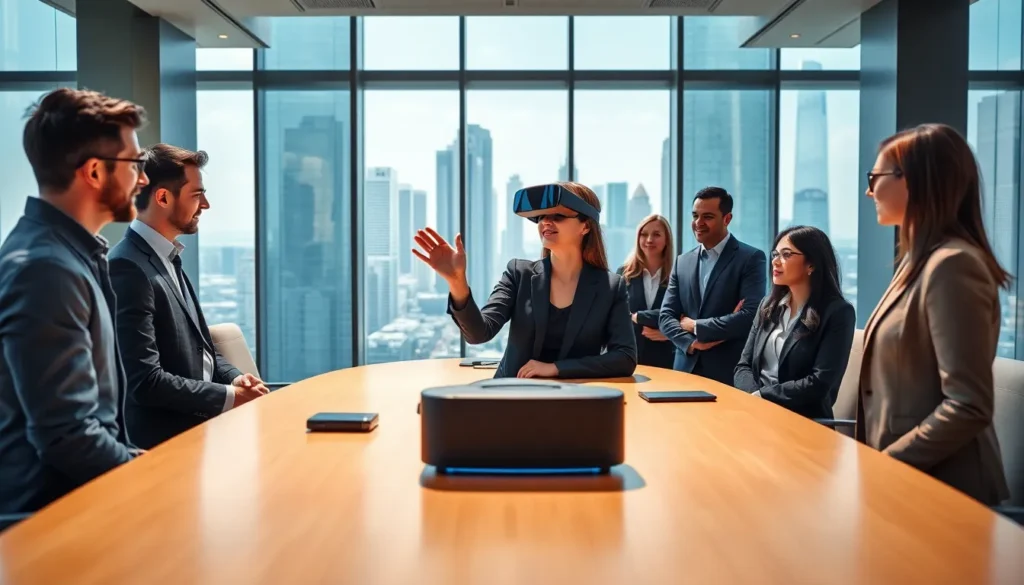In a world where technology evolves faster than a toddler on a sugar rush, distinguishing between mixed reality and augmented reality might feel like deciphering ancient hieroglyphics. Fear not. We’re about to unravel these techy concepts in a fun, digestible way. Think of it as sorting your sock drawer, don’t worry, it’s not as dull as it sounds. By the end of this read, you’ll be the savvy friend who enlightens the group at the next tech-themed gathering.
Table of Contents
ToggleWhat Is Augmented Reality?

Augmented reality, better known as AR, superimposes digital elements onto the real world, enhancing one’s perception of reality. Imagine looking through your smartphone camera and seeing a cat pop into your living room, which you can then pet by swiping your screen, cute, right? This seamless integration of the digital and physical realms allows users to interact with both simultaneously.
How Augmented Reality Works
AR works through a variety of devices ranging from smartphones and tablets to specialized AR glasses. The fundamental tech behind it involves computer vision, simultaneous localization, and mapping (SLAM), and overlaying graphics onto the real world. As users move through their environments, AR applications recognize and track environments to place digital content accurately. This convergence between real and virtual not only enhances but also personalizes experiences.
Applications of Augmented Reality
AR isn’t just for playful kitten overlays. Industries like retail, gaming, education, and healthcare are rapidly leveraging this technology. For instance, retailers allow you to visualize how that couch might look in your living room before buying it. In gaming, platforms like Pokémon Go thrust players into a fantastical world layered over the real one, making for an interactive quest. Meanwhile, in education, AR can turn complex concepts into 3D visuals, ensuring students grasp the subject matter without needing a PhD in rocket science.
What Is Mixed Reality?
Mixed reality (MR) combines the best of both augmented reality and virtual reality, creating a unique experience where the digital and physical worlds coexist in real-time and interact with each other. Think of mixed reality as the ultimate fusion dining experience, serving up the savory flavors of various tech elements. In MR, digital objects not only overlay real ones but can also respond to them in real-time.
How Mixed Reality Works
Mixed reality utilizes advanced technologies such as environment recognition, depth mapping, and spatial awareness to integrate and interact with the physical environment. This means that if a user were to wave their hand in front of a virtual object, that object can react as if it were genuinely interacting with the user’s hand. MR devices, like Microsoft’s HoloLens, rely on technology that offers a full 3D understanding of a space, which then allows for seamless interaction and adjustment of the digital content based on user movements.
Applications of Mixed Reality
From training simulations in military and healthcare to immersive art installations and virtual meetings, the applications of mixed reality are vast. Organizing a virtual conference where participants can manipulate 3D data as if they were all in the same room comes in handy for many industries. Not to mention, MR also finds its place in architectural design, allowing designers to view and modify digital models within the physical space they will occupy.
Key Differences Between Mixed Reality and Augmented Reality
While both mixed reality and augmented reality enhance user experiences through digital content, there are significant differences.
User Experience and Interaction
When it comes to user experience, AR offers a more passive engagement, where digital content is often viewed without true interaction. Users see the content but may not truly engage with it beyond simple gestures. In contrast, MR allows for deeper interaction, where users manipulate and interact with digital objects as if they were part of the physical environment, creating an immersive experience.
Technological Frameworks
AR is commonly built on simpler frameworks, often relying on basic placement and recognition, which makes it relatively easier to develop. Conversely, MR systems are more complex, requiring advanced algorithms for understanding physical spaces and user interactions. This complexity results in an experience that feels more cohesive and integrated than traditional AR.
Future Trends in Mixed Reality and Augmented Reality
The future of both mixed reality and augmented reality is brimming with potential. As technology continues to advance, industries are set to experience significant transformations. MR could revolutionize training processes, offering hands-on learning without the risks involved in real-life training scenarios.
Potential Impact on Industries
Expect to see major shifts in sectors such as healthcare, where AR and MR can enable surgeons to get real-time data during procedures. Retailers may employ MR to create interactive shopping experiences that draw customers into stores while allowing them to interact with products more practically. Education also stands to gain immensely, providing students with engaging, immersive lessons that cater to different learning styles.






